
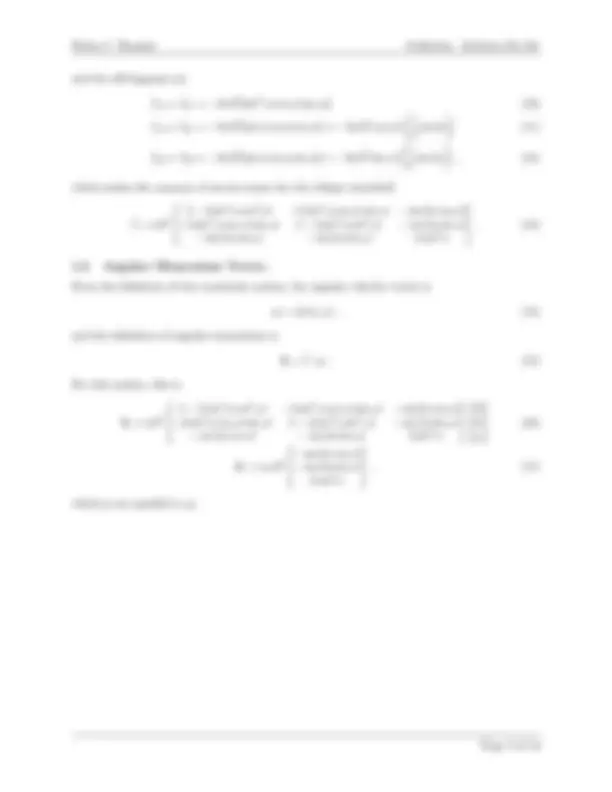
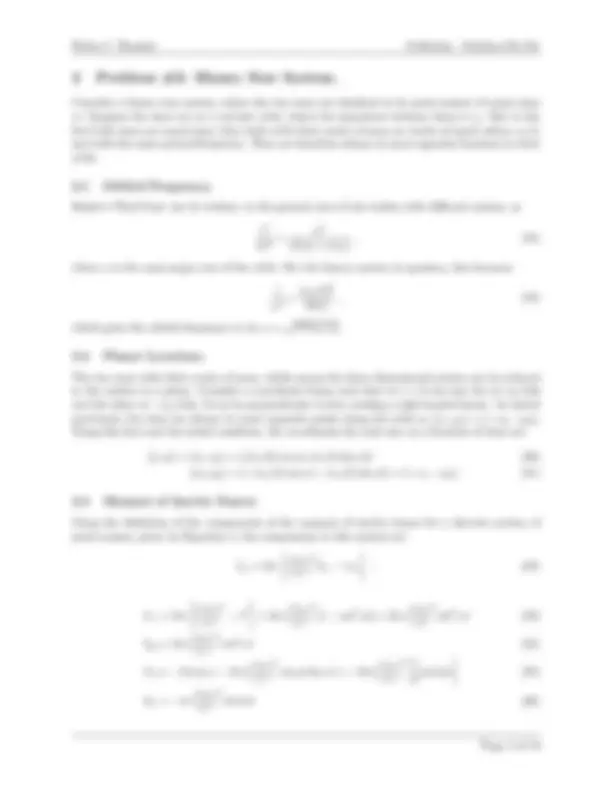

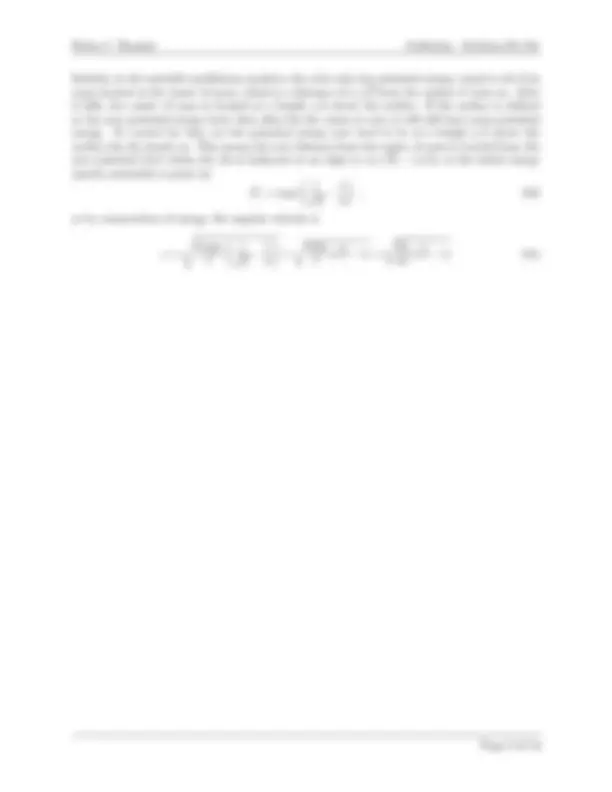
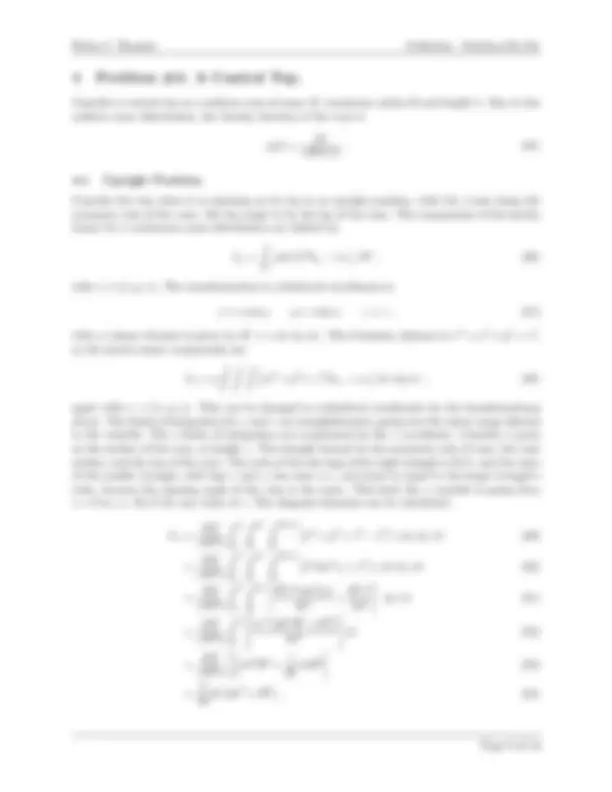
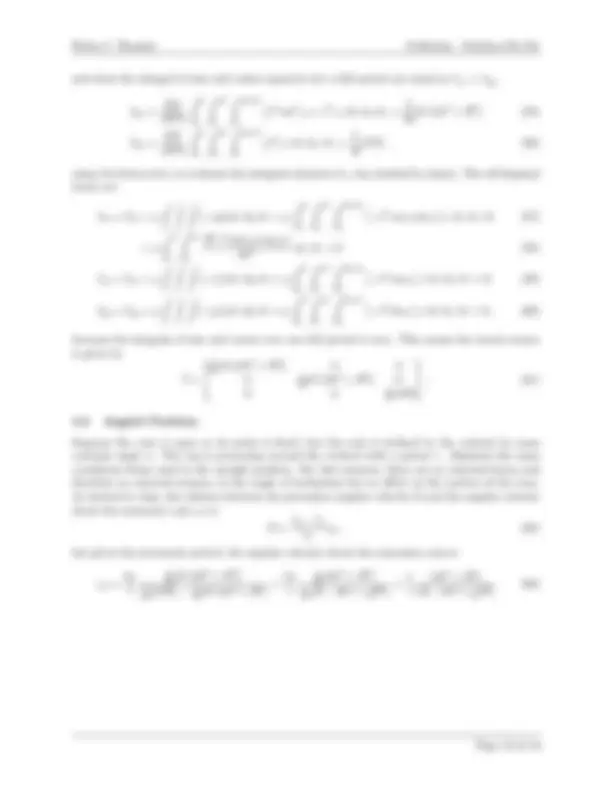
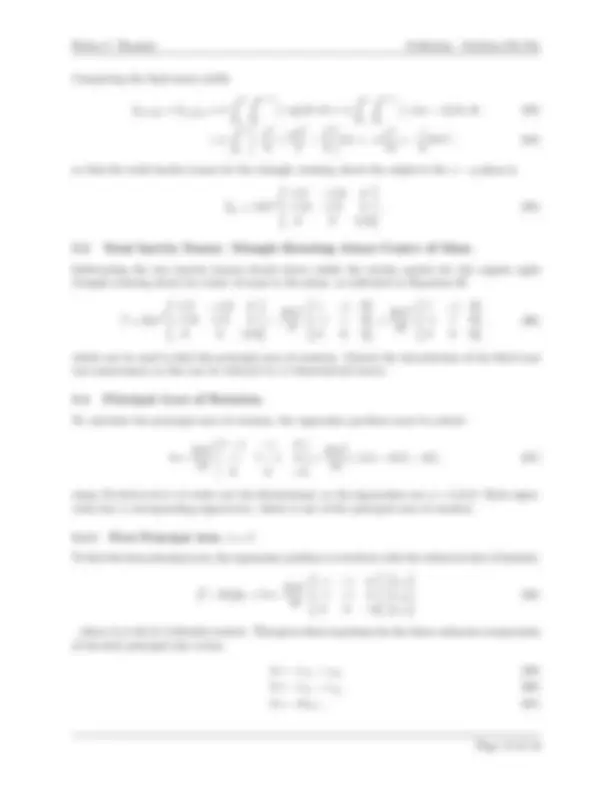
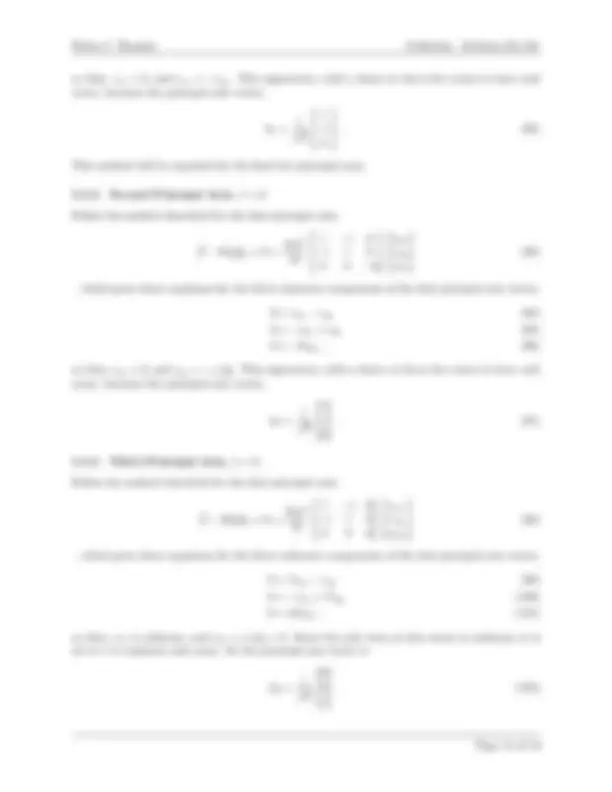
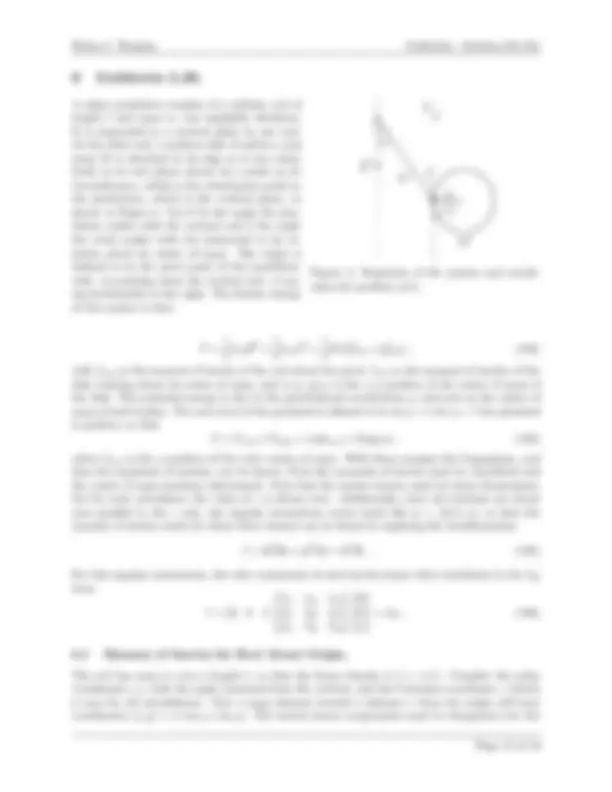


Study with the several resources on Docsity

Earn points by helping other students or get them with a premium plan


Prepare for your exams
Study with the several resources on Docsity

Earn points to download
Earn points by helping other students or get them with a premium plan
Community
Ask the community for help and clear up your study doubts
Discover the best universities in your country according to Docsity users
Free resources
Download our free guides on studying techniques, anxiety management strategies, and thesis advice from Docsity tutors
The analysis of moment of inertia tensors for oblique dumbbell and binary star systems using the given equations and coordinates. It includes the calculation of diagonal and off-diagonal components, and the derivation of the angular momentum vector.
What you will learn
Typology: Exercises
1 / 16

This page cannot be seen from the preview
Don't miss anything!










Northwestern University, Classical Mechanics
A dumbbell is formed by connecting two small spherical masses of mass m with a massless rod of length 2b. The rod is attached to an axle in such a way that it makes a constant angle φ with the axle. The dumbbell rotates about the axle at a rate ω, as shown in Figure 1. Using this information, the moment of inertia tensor Iˆ and the angular momentum vector L can be found. The coordinate system will be defined such that ˆz points up in Figure 1, the other two coordi- nates ˆx and ˆy create a right handed Cartesian coordinate system with the origin at the point on the barbell that intersects the vertical line in Figure 1, half the length of the dumbbell. Let the angle the masses are around the axis of ro- tation be denoted by θ = ωt. Let θ = 0 point along ˆx, thus
rx = b sin φ cos ωt (1) ry = b sin φ sin ωt (2) rz = b cos φ (3)
Figure 1: Depiction of the oblique dumbbell sys- tem examined in problem #1.
The definition of the components of the moment of inertia tensor of a system of discrete masses components is
Iij =
α
mα
r^2 (α)δij − r(α)ir(α)j
where δij is the Kronecker delta and r^2 is the Cartesian distance. In this system, the masses are always a constant distance from the origin, and make the same angle with the vertical axis. For this two mass system the moment of inertia components are
Iij = m
b^2 δij − r(1)ir(1)j
b^2 δij − r(2)ir(2)j
but r(1) = −r(2), and ri = beˆi, so
Iij = 2mb^2 [δij − ˆeieˆj ]. (6)
Therefore the diagonal components are
I 11 = 2mb^2 [1 − sin^2 φ cos^2 ωt] (7) I 22 = 2mb^2 [1 − sin^2 φ sin^2 ωt] (8) I 33 = 2mb^2 [1 − cos^2 φ] = 2mb^2 sin^2 φ , (9)
Consider a binary star system, where the two stars are idealized to be point masses of equal mass m. Suppose the stars are on a circular orbit, where the separation between them is r 0. Due to the fact both stars are equal mass, they both orbit their center of mass on circles of equal radius, r 0 /2, and with the same period/frequency. They are therefore always at exact opposite locations in their orbit.
Kepler’s Third Law can be written, in the general case of two bodies with different masses, as
τ 2 4 π^2
a^3 G(m 1 + m 2 )
where a is the semi-major axis of the orbit. For the binary system in question, this becomes
1 ω^2
(r 0 /2)^3 2 Gm
which gives the orbital frequency to be ω =
24 Gm/r^30.
The two stars orbit their center of mass, which means the three dimensional system can be reduced to the motion in a plane. Consider a coordinate frame such that at t = 0 one star lies at (r 0 /2)ˆx and the other at −(r 0 /2)ˆx. Let ˆy be perpendicular to this, making a right handed frame. As stated previously, the stars are always at exact opposite points along the orbit so {x 1 , y 1 } = {−x 2 , −y 2 }. Using this fact and the initial condition, the coordinates for each star as a function of time are
{x, y} ≡ {x 1 , y 1 } = {(r 0 /2) cos ωt, (r 0 /2) sin ωt} (20) {x 2 , y 2 } = {−(r 0 /2) cos ωt, −(r 0 /2) sin ωt} = {−x 1 , −y 1 }. (21)
Using the definition of the components of the moment of inertia tensor for a discrete system of point masses, given by Equation 4, the components in this system are
Iij = 2m
r 0 2
δij − rirj
I 11 = 2m
r 0 2
− x^2
= 2m
( (^) r 0 2
[1 − cos^2 ωt] = 2m
( (^) r 0 2
sin^2 ωt (23)
I 22 = 2m
( (^) r 0 2
cos^2 ωt (24)
I 12 = − 2 mxy = − 2 m
( (^) r 0 2
cos ωt sin ωt = − 2 m
( (^) r 0 2
sin 2ωt
I 21 = −m
( (^) r 0 2
sin 2ωt (26)
which makes the moment of inertia tensor for this binary system
Iˆ = m
( (^) r 0 2
2 sin^2 ωt − sin 2ωt 0 − sin 2ωt 2 cos^2 ωt 0 0 0 2
because a third dimension is required due to the axis of rotation. However, for rotations about this axis, there is no motion in the ˆz direction, so z = 0 in all integrals.
mass of the cube, such that the faces of the cube are at ±a/2 in each coordinate direction. Using this coordinate system and the definition of the components of inertia tensor for a continuous mass distribution, Equation 28, the components are given by
Iij = m a^3
∫ (^) a/ 2
−a/ 2
∫ (^) a/ 2
−a/ 2
∫ (^) a/ 2
−a/ 2
(x^2 + y^2 + z^2 )δij − rirj
dx dy dz. (34)
The first component is
m a^3
∫ (^) a/ 2
−a/ 2
∫ (^) a/ 2
−a/ 2
∫ (^) a/ 2
−a/ 2
(x^2 + y^2 + z^2 − x^2
dx dy dz (35)
m a^3
∫ (^) a/ 2
−a/ 2
dx
∫ (^) a/ 2
−a/ 2
y^2 dy
∫ (^) a/ 2
−a/ 2
z^2 dz =
m a^3
a^5 6
which by permutation is also equal to I 22 and I 33 , with for a value of (1/6)ma^2. The off-diagonal components are
Iij = m a^3
∫ (^) a/ 2
−a/ 2
∫ (^) a/ 2
−a/ 2
∫ (^) a/ 2
−a/ 2
[−rirj ] dx dy dz , (37)
which are all zero becuase symmetric integrals of an odd function are zero, and the integrands are linear in two of the coordinates for each component. Therefore, the inertia tensor of a cube about an axis passing through its center of mass, normal to two faces is
Iˆcube =^1 6 ma^2
Which makes the total inertia tensor of a cube rotating about the edge aligned with the x axis
ma^2
ma^2
ma^2
Given the complete moment of inertia tensor, the moment of inertia tensor can be found by com- puting I = ˆn†^ Iˆ ˆn , (40)
where ˆn is a unit vector pointing along the axis of rotation, and the dagger denotes the transpose. In this case ˆn = ˆx, so the moment of inertia about the x-axis is
ma^2 [1, 0 , 0]
ma^2 [4, 0 , 0]
ma^2. (41)
Assume the edge of the die does not slide on the table. You balance the die on its edge, and eventually it topples. Given that the moment of inertia scalar about the corner of the cube is I = (2/3)ma^2 , the energy the cube has just before it hits the table (where it has no potential) is
Ef =
Iω^2. (42)
Initially, in the unstable equilibrium position, the cube only has potential energy, equal to all of its mass located at the center of mass, which is a distance of a/
2 from the surface it rests on. After it falls, the center of mass is located at a height a/2 above the surface. If the surface is defined as the zero potential energy level, then after the die comes to rest, it will still have some potential energy. To correct for this, set the potential energy zero level to be at a height a/2 above the surface the die stands on. This means the new distance from the center of mass is located from the zero potential level (when the die is balanced on an edge) is (a/
Ei = mga
so by conservation of energy, the angular velocity is
ω =
2 mga I
mga I
3 g 2 a
note that the integral of sine and cosine squared over a full period are equal so Ixx = Iyy.
πR^3 h
∫ (^) h
0
∫ (^2) π
0
∫ (^) Rz/h
0
s^2 cos^2 ϕ + z^2
s ds dϕ dz =
4 h^2 + R^2
πR^3 h
∫ (^) h
0
∫ (^2) π
0
∫ (^) Rz/h
0
s^2
s ds dϕ dz =
using Mathematica to evaluate the integrals (element Ixx was checked by hand). The off diagonal terms are
I 12 = I 21 = ρ
[−xy] dx dy dz = ρ
∫ (^) h
0
∫ (^2) π
0
∫ (^) Rz/h
0
−s^2 cos ϕ sin ϕ
s ds dϕ dz (57)
= ρ
∫ (^) h
0
∫ (^2) π
0
R^4 z^4 sin(ϕ) cos(ϕ) 4 h^4 dϕ dz = 0 (58)
I 13 = I 31 = ρ
[−xz] dx dy dz = ρ
∫ (^) h
0
∫ (^2) π
0
∫ (^) Rz/h
0
−s^2 cos ϕ
s ds dϕ dz = 0 (59)
I 23 = I 32 = ρ
[−yz] dx dy dz = ρ
∫ (^) h
0
∫ (^2) π
0
∫ (^) Rz/h
0
−s^2 sin ϕ
s ds dϕ dz = 0 , (60)
because the integrals of sine and cosine over one full period is zero. This means the inertia tensor is given by
Iˆ =
3 20 M^
4 h^2 + R^2
4 h^2 + R^2
Suppose the cone is spun so its point is fixed, but the axis is inclined to the vertical by some constant angle α. The top is precessing around the vertical with a period τ. Maintain the same coordinate frame used in the upright position. For this scenario, there are no external forces and therefore no external torques, so the angle of inclination has no effect on the motion of the cone. As derived in class, the relation between the precession angular velocity Ω and the angular velocity about the symmetry axis ω 3 is
Ω =
ω 3 , (62)
but given the precession period, the angular velocity about the symmetry axis is
ω 3 = 2 π τ
3 20 M^
4 h^2 + R^2
− 203 M (4h^2 + R^2 )
2 π τ
1 20 (4h
1 10 (R^ −^2 h
π τ
(4h^2 + R^2 ) (R − 2 h^2 + 12 R^2 )
Consider a flat rigid body in the shape of a 45o right triangle with uniform mass density and to- tal mass M. The length of each leg is a, so the density is σ = 2M/a^2. Use a Cartesian coordi- nate frame with ˆx and ˆy pointing along the legs of the right triangle, with the origin located at the right angle. Consider three inertia tensors: Iˆ 1 the inertia tensor of the triangle about its cen- ter of mass in the x−y plane, Iˆ 2 the inertia tensor of the triangle rotating about the origin in the x − y plane, and Iˆ 3 the inertia tensor of a point mass of mass M rotating around the origin in the x − y plane. All rotations are around axes pointing in the ˆz direction, thus the parallel axis
theorem applies,
Figure 3: Diagram of geometric plate and coor- dinate system.
For a triangle rotating about its center of mass, the moment of inertia of interest is Iˆ 1 , which will be called Iˆ from this point on. For clarity let Iˆtri = Iˆ 2 , and IˆCM = Iˆ 3. Using this notation, the inertia tensor of the triangle rotating about its center of mass is given by
Iˆ = Iˆtri − IˆCM , (65)
which can be calculated after finding the secondary inertia tensors.
The components of the inertia tensor for the point mass of mass M rotating around the origin is given by IˆCM (ij) = M (r^2 δij − rirj ) , (66)
for ri ∈ {x, y, z}, with the polar distance r^2 = x^2 + y^2. For the rotation of interest, z = 0 in all integrals. The center of mass of a triangle is located a distance a/3 from each leg, which is a distance
2 a/3 away from the origin, so rCM = (xCM , yCM ) = (a/ 3 , a/3). The diagonal elements are
ICM (11) = M (r^2 − x^2 ) = M y^2 = M a^2 9 = M x^2 = ICM (22) (67)
ICM (33) = M (r^2 − z^2 ) = M (x^2 + y^2 ) =
2 M a^2 9
and the off diagonals,
ICM (12) = ICM (21) = M (−xy) = M a^2 9
ICM (13) = ICM (31) = M (−xz) = 0 = M (−yz) = ICM (23) = ICM (32) , (70)
Computing the final terms yields
Itri(12) = Itri(21) = σ
∫ (^) a
0
∫ (^) a−x
0
[−sy] ds dx = σ
∫ (^) a
0
∫ (^) a−x
0
[−s(a − s)] ds dx (83)
= σ
∫ (^) a
0
a^3 6
ax^2 2
x^3 3
dx = −σ a^4 12
M a^2 , (84)
so that the total inertia tensor for the triangle rotating about the origin in the x − y plane is
Iˆtri = M a^2
Subtracting the two inertia tensors found above yields the inertia matrix for the regular right triangle rotating about its center of mass in the plane, as indicated in Equation 65
Iˆ = M a^2
(^) − M a
2 9
(^) = M a
2 18
which can be used to find the principal axes of rotation. Clearly the introduction of the third axis was unnecessary as this can be reduced to a 2 dimensional tensor.
To calculate the principal axes of rotation, the eigenvalue problem must be solved:
M a^2 18
7 − λ − 1 0 − 1 7 − λ 0 0 0 −λ
M a^2 18
[−λ(λ − 8)(λ − 6)] , (87)
using Mathematica to write out the determinant, so the eigenvalues are λ = 8, 6 , 0. Each eigen- value has a corresponding eigenvector, which is one of the principal axes of rotation.
5.4.1 First Principal Axis, λ = 8
To find the first principal axis, the eigenvalue problem is rewritten with the selected value of lambda:
[ Iˆ − 8 I 3 ]ˆe 1 = 0 = M a^2 18
e 1 x e 1 y e 1 z
, where I 3 is the 3×3 identity matrix. This gives three equations for the three unknown components of the first principal axis vector,
0 = −e 1 x − e 1 y (89) 0 = −e 1 x − e 1 y (90) 0 = − 8 e 1 z , (91)
so that, e 1 z = 0, and e 1 x = −e 1 y. This eigenvector, with a factor to force the vector to have unit norm, becomes the principal axis vector,
ˆe 1 =
This method will be repeated for the final two principal axes.
5.4.2 Second Principal Axis, λ = 6
Follow the method described for the first principal axis:
[ Iˆ − 6 I 3 ]ˆe 2 = 0 = M a^2 18
e 2 x e 2 y e 2 z
, which gives three equations for the three unknown components of the first principal axis vector,
0 = e 2 x − e 2 y (94) 0 = −e 2 x + e 2 y (95) 0 = − 6 e 2 z , (96)
so that, e 2 z = 0, and e 2 x = −e 12 y. This eigenvector, with a factor to force the vector to have unit norm, becomes the principal axis vector,
ˆe 2 =
5.4.3 Third Principal Axis, λ = 0
Follow the method described for the first principal axis:
[ Iˆ − 0 I 3 ]ˆe 2 = 0 =
M a^2 18
e 3 x e 3 y e 23 z
, which gives three equations for the three unknown components of the first principal axis vector,
0 = 7e 3 x − e 3 y (99) 0 = −e 3 x + 7e 3 y (100) 0 = (0)e 3 z , (101)
so that, e 3 z is arbitrary, and e 3 x = e 13 y = 0. Since the only term in this vector is arbitrary, it is set to 1 to maintain unit norm. So the principal axis vector is
ˆe 2 =
(radial) length of the rod, so r = [0, `]. Therefore the components of the inertia tensor for the rod are
Iij = λ
o
[r^2 δij − rirj ]dr (107)
with ri ∈ (x, y, x). The only component that matters is
Irod = I 33 = λ
o
r^2 dr =
m `
m`^2. (108)
Consider a disk of radius a and mass M oriented in the x−y plane of a Cartesian coordinate system with the center at the origin. In these coordinates a mass element located at r has coordinates (x, y), and all z values are zero. The surface density of this body is σ = M/(πa^2 ). For any given x value, the minimum value of y is −
a^2 − x^2 , and the maximum is +
a^2 − x^2 , so the components of the inertia tensor are given by
I = σ
∫ (^) a
−a
∫ √a (^2) −x 2
− √ a^2 −x^2
[(x^2 + y^2 )δij − rirj ]dydx , (109)
with ri ∈ (x, y, x). The moment of inertia is then
Icenter = I 33 = σ
∫ (^) a
−a
∫ (^) (a (^2) −x (^2) ) 1 / 2
−(a^2 −x^2 )^1 /^2
(x^2 + y^2 )dy dx = σ a^4 π 2
M a^2 , (110)
using Mathematica to evaluate the integral. But because the disk rotates about a point on its circumference, the parallel axis theorem states Irot = Icenter + M a^2 , so the total moment of inertia for the disk is 32 M a^2.
The disk is attached to the rod by a point on its circumference, therefore the position of the center of mass of the disk is the sum of the position of the end of the rod and the position of the disks center of mass with respect to the end of the rod, or
xCM = a sin φ + sin θ ⇒ x˙CM = a φ˙ cos φ + θ˙ cos θ (111) yCM = a cos φ + cos θ ⇒ y˙CM = −a φ˙ sin φ − θ˙ sin θ. (112)
The kinetic energy is dependent on the sum of the squares of these derivatives,
x^2 CM + y^2 CM = a^2 φ˙^2 + 2aθ˙ φ˙ cos(θ − φ) +^2 θ˙^2. (113)
Using the above information and Equations 103 and 104, it is found that
T =
m`^2 θ˙^2 +
M a^2 φ˙^2 +
M [a^2 φ˙^2 + 2aθ˙ φ˙ cos(θ − φ) +^2 θ˙^2 ] (114) U = mg(cos θ) + M g(a cos φ + cos θ). (115)
So the Lagrangian is
L = T − U (116)
=
(m + 3M )`^2 θ˙^2 +
M a^2 φ˙^2 +
M [2aθ˙ φ˙ cos(θ − φ)] − (m + M )g cos θ − M ga cos φ. (117)